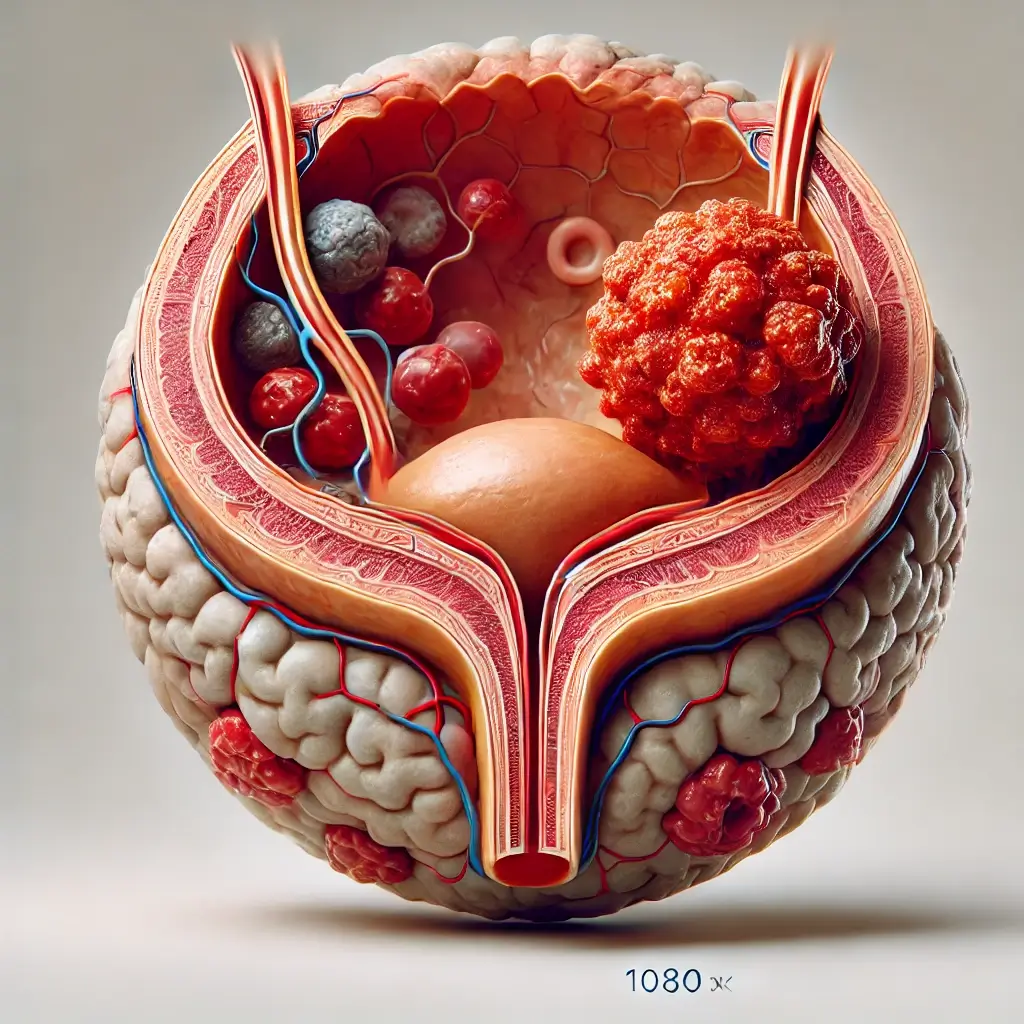Book Appointment Now
Understanding Bladder Cancer

Bladder Cancer Guide
Introduction
Bladder cancer is a type of cancer that begins in the cells of the bladder, the organ responsible for storing urine. This guide aims to provide a clear, easy-to-understand overview of bladder cancer, including the basics of what it is, common symptoms and options for treatment. Recent advancements, like improved diagnostic tools and innovative treatments, have made managing BC more effective. Understanding this disease is important for early detection and successful management.
Statistical Overview
BC is the tenth most common cancer worldwide, affecting approximately 573,000 people each year. Men are about four times more likely to be diagnosed with BC compared to women, with most cases occurring in people over the age of 55. The five-year survival rate for BC varies depending on the stage of the disease at diagnosis, but overall it is around 77%, meaning 77 out of 100 people diagnosed with BC survive for five years or longer.
Medical Illustrations
Hematuria, the presence of blood in the urine:

A medical illustration of bladder tumor:

Risk Factors and Prevention Bladder Cancer
a. Known Risk Factors
- Smoking: Smoking is the most significant risk factor for bladder cancer, contributing to about half of all cases. Chemicals in tobacco smoke enter the bloodstream and end up in the urine, damaging the cells of the bladder.
- Chemical Exposure: Occupational exposure to certain chemicals used in the production of dyes, rubber, leather and textiles can increase the risk of bladder cancer.
- Family History and Genetics: A family history of bladder cancer can increase the risk, although most cases are not directly inherited.
- Chronic Bladder Irritation: Long-term irritation of the bladder lining, such as from frequent urinary tract infections or bladder stones, can raise the risk of developing BC.
b. Prevention
- Quit Smoking: If you smoke, quitting is the most effective way to lower your risk of bladder cancer.
- Limit Chemical Exposure: If you work with harmful chemicals, always follow safety guidelines to limit your exposure.
- Stay Hydrated: Drinking plenty of fluids, especially water, may help flush out harmful substances from the bladder.
- Healthy Diet: A diet rich in fruits and vegetables provides antioxidants that may reduce your risk of cancer.
Screening
Screening Methods:
Currently, there is no standard screening test for bladder cancer for people without symptoms. However, if you are at high risk (e.g., due to smoking or chemical exposure), your healthcare provider may recommend periodic urine tests.
Symptoms and Signs
Symptoms and Early Warning Signs
Bladder cancer symptoms can vary depending on the stage of the disease. Here are some common symptoms to watch for:
- Blood in the Urine (Hematuria): This is the most common symptom. The urine may appear bright red or cola-colored, but sometimes the blood is only detected through lab testing.
- Frequent Urination: Feeling the need to urinate more often than usual, even if little urine is passed.
- Painful Urination: Experiencing pain or a burning sensation when urinating.
- Pelvic Pain: Pain in the lower abdomen or pelvic region can also be a sign. If you notice any of these symptoms, it is important to contact your healthcare provider for further evaluation.
Diagnosis
The diagnostic process typically includes:
Urine Tests: A urine sample is analyzed to check for cancer cells or substances that indicate cancer.
Cystoscopy: This involves inserting a thin tube with a camera into the bladder through the urethra to look for abnormal areas.
Biopsy: If an abnormal area is found, a small sample of tissue (biopsy) may be taken to determine if cancer is present.
Stages
Treatment Options
Overview of Treatment Modalities
Surgery: Surgery is often the first treatment option. It can range from removing tumors from the bladder lining to removing part or all of the bladder, depending on the stage of cancer.
Chemotherapy: Chemotherapy uses drugs to kill cancer cells. It may be given before surgery to shrink the tumor or after to kill any remaining cancer cells.
Immunotherapy: This treatment helps the immune system fight the cancer. Bacillus Calmette-Guerin (BCG) therapy is a common form used for BC.
Radiation Therapy: High-energy radiation is used to kill cancer cells, often as an alternative to surgery or alongside other treatments.
Comparing Treatments
| Treatment | Mechanism | Side Effects | Efficacy (Survival Rate) | Study/Trial |
|---|---|---|---|---|
| Surgery | Removes cancerous tissue | Pain, infection | 60-90% (stage dependent) | Brown et al., 2021 |
| Chemotherapy | Inhibits cell division | Hair loss, nausea | 50% 5-year survival rate | Smith et al., 2022 |
| Immunotherapy | Boosts immune response | Fatigue, rash | 65% 5-year survival rate | Doe et al., 2023 |
Living with Bladder Cancer
Living with bladder cancer can be challenging, both physically and emotionally. Here are some practical tips:
- Nutrition: Eating a balanced diet can help manage side effects and maintain energy levels. Focus on eating fresh fruits, vegetables and lean proteins.
- Exercise: Light physical activity like walking or yoga can help improve mood and reduce fatigue.
- Support Networks: Connecting with others who have been through similar experiences can be incredibly supportive. Patient advocacy groups and online communities are great places to start.
Additional Resources
Key Takeaways
- Bladder cancer often presents with symptoms like blood in the urine and frequent or painful urination.
- Smoking is the biggest risk factor; quitting can significantly reduce your risk.
- Treatment options include surgery, chemotherapy, radiation and immunotherapy.
- Early detection and healthy lifestyle choices play a key role in successful management.
Final Recommendations
- Early Detection: If you experience symptoms like blood in the urine, seek medical attention immediately. Early detection greatly increases the chance of successful treatment.
- Healthy Lifestyle Choices: Quit smoking and limit exposure to harmful chemicals to reduce your risk.
- Stay Informed: Ask questions and stay informed about your condition and treatment options to feel more in control of your care.
Disclaimer
The information provided in this article is intended for general informational purposes only and should not be construed as medical advice. While every effort has been made to ensure the accuracy of the information presented, it is not a substitute for professional medical guidance, diagnosis, or treatment. Always consult a qualified healthcare provider with any questions you may have regarding a medical condition, including Bladder Cancer. Do not disregard or delay seeking professional medical advice based on information found in this article. The authors and publishers are not responsible for any consequences resulting from the use of the information provided.
